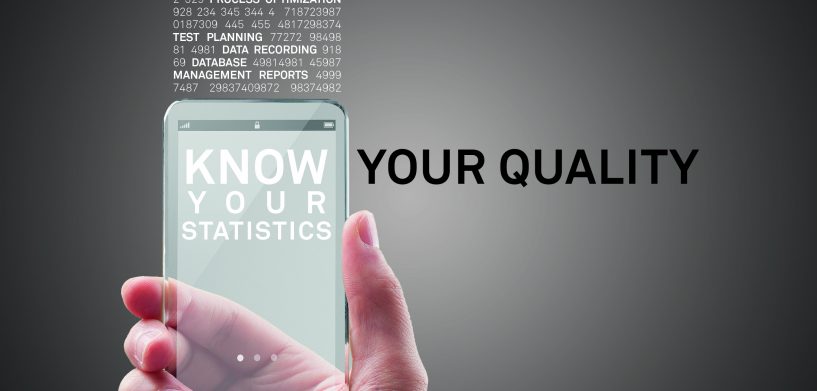BK: Welcome to HxGN Radio. My name is Brian, and I’m with Tom Stewart, president of Q-DAS Incorporated. Q-DAS provides statistical analysis of manufacturing and process data, and data collection. Today we’re going to be discussing what’s unique about the Q-DAS organisation and how they provide a better vision into the process. Tom, thanks for joining us.
TS: Hi, you’re welcome. Thanks for having me.
BK: Appreciate it. All right. So, first of all, tell me a little bit about Q-DAS.
TS: Well, Q-DAS was founded in 1988 primarily as a computer-based training company to teach manufacturing engineers the impact of using different methods for statistical analyses and processes.
BK: Mm-hmm. Excellent. So, what are some of the key differences between Q-DAS and every other supplier of SPC software?
TS: Well, first off, we’re able to deal with non-normal data.
BK: Mm-hmm.
TS: And every time a manufacturing company improves a process or adjusts a process to improve their tool life, save costs, or make better quality parts, they’re driving the data to be non-normal, meaning that it doesn’t fit a standard bell curve.
BK: Interesting. So, it’s not very personalised, then, at that point.
TS: That’s right. And what happens with most traditional companies in our business line is that—and it’s also, by the way, taught in most of the major universities still—
BK: Mm-hmm.
TS: —is that you must transform the data in order to calculate the capability and quality indexes that represent the process, and when you do that, then you lose vision into the process.
BK: Yeah, yeah.
TS: Q-DAS, on the other hand, can analyse the data correctly as it is, provide the correct results, and provide the engineers and users a better vision, a more direct vision, directly into the process.
BK: Just a question on this one: what are some problems that— let’s just say, companies and industries in general can run into when they don’t have the correct vision, as you’re talking about the data that’s really specific?
TS: Well, in metal-cutting applications, they use tools to cut the part. And the tools wear out, and when they change the tool to put a new one in, the data shifts to the size of the new tool, right?
BK: Sure.
TS: And so that represents two different populations of data: one with the old tool; one with the new tool. And you can see that in the bar graphs and in the histograms and in the value charts and control charts, and that’s an important thing to recognise when you change the tool. When you’re using a more traditional SPC method, then you’re going to transform that data from two different distribution models into one. Then, so, that data gets mixed up and confused, and the engineer loses the vision to be able to see that there was a tool change.
BK: Interesting. So, then you’ve got, maybe projects that didn’t come out exactly as accurate as you were hoping or workarounds, or people have to fix things.
TS: All of that.
BK: Yeah.
TS: But even more so, in precision metal-removal processes—
BK: Mm-hmm.
TS: —the customer still has to worry about tool life. So they’re making all kinds of adjustments into the process.
BK: Mm-hmm.
TS: And they’re never sending the dimension of the part when they adjust the tool. They’re never sending it to the middle of the tolerance zone.
BK: Yeah.
TS: They’re generally sending it to a target value, which is below the nominal, or the middle, of the tolerance zone. And so that in itself makes the data non-normal.
BK: Mm-hmm.
TS: So, the risks are, when they use the data-transformation methods, is that they lose vision in the process, it’s more complicated for people to understand, and it gives them the wrong quality metric; it gives them a wrong value.
BK: Sure.
TS: And that can be wrong to the good side or wrong to the bad side.
BK: Okay. But it can cause loss of time, loss of money, etc., etc.
TS: All of that.
BK: On and on.
TS: Confusing.
BK: So, Q-DAS solves that.
TS: That’s right.
BK: I like that.
TS: And we also take care of analysing the data according to international standards, national standards, regional standards, and company-guidelines standards. And they’re all different. They’re not the same. They’re adjusted based on the geography or the standard organisations. And so we’re able to configure the product to make the analysis according to those standard specifications.
BK: Excellent. That’s very great. So, now, Hexagon had another SPC product named DataPage. So how’s Q-DAS different from that one?
TS: Yeah. Actually, DataPage is quite a good traditional product. However, it doesn’t have the ability to configure to those different statistical standards. It had one standard, so the Q-DAS product can adjust the statistical methods to fixed evaluations. We can have evaluations for the gauge acceptance, for the machine acceptance, for standard production when you’re inspecting 100 percent of the parts or a standard production when you’re inspecting some of the parts.
BK: Mm-hmm.
TS: So that becomes kind of the business rules about how you make the analysis on the data.
BK: Sure.
TS: And each company has different business rules. And in a few minutes we can configure the product to map to those.
BK: Wow.
TS: That’s one key area. The next key area is that we have interfaces to more than 105 different suppliers of measurement tests and assembly systems, where DataPage had the Hexagon products.
BK: Mm-hmm.
TS: And so, even some of these products are competitive products, but we can take data from all of them, plus we have interfaces for more than 300 RS232 or USB metrology devices that plug into the PC that gets that data. We have interfaces for PLCs through the OPC connection, and we even have a way to read paper charts and bring it into this century’s method of data analysis.
BK: Excellent. Very exciting. Good to hear about all these. Now, with that, is there a transition program—
TS: Yeah.
BK: —for current users of DataPage?
TS: Yeah, absolutely. There’s a current program that’s running. It’ll run probably for the next year, into June 2019. It allows current users of DataPage to trade in their DataPage licenses and get an equivalent Q-DAS license—
BK: Yeah.
TS: —plus some remote install services and training to get them to the new product.
BK: It’s great. You don’t always see that.
TS: No.
BK: Usually it’s a, “Hey, we’ve updated. Go buy the new thing.”
TS: Yeah. Well, a key point for Q-DAS as well as Hexagon is customer satisfaction.
BK: Mm-hmm.
TS: And the important point is to not inconvenience the customer with bureaucracy or a price penalty—
BK: Sure.
TS: —because of an improvement in a product. And the truth is, so far every customer that’s taken advantage of the offer has also extended the product into other parts of their plant, because we can take data from all the different measurement tests and assembly systems.
BK: That’s good. So, you’re making them happy, and you’re giving them exactly what they need.
TS: That’s right.
BK: I love it. I love it. All right. So, why is the evaluation of non-normal data important?
TS: It’s import—
BK: And we talked about this, I know. But a little bit more information on that.
TS: Yeah, it’s okay. It’s important because 98 percent of all manufacturing data is non-normal.
BK: Mm-hmm.
TS: And so you need a method to deal with that. Alternatively, you’d have to look at the data, manually decide what kind of data model fits it, manually decide what kind of calculation methods to use to derive the indexes, and then do the study. And then you’d have to remember the same thing the next time you did it—
BK: Yeah.
TS: —and the next time, and the next time, and the next time. So chances are two different people would make different decisions, and the data wouldn’t be comparable. So the Q-DAS method is set up one time. It’s in something called a configuration of evaluation—
BK: Mm-hmm.
TS: —so that we can apply it to every system in the plant. And the calculations are then applied automatically. There’s no manual decisions so that results are comparable time over time.
BK: Why don’t other suppliers do this?
TS: Boy, that’s a really good question, because even the major educational institutions are still pushing these 1970s and ’80s methods. And the truth is they come from the 17th century, to be honest. A guy named Gauss—
BK: Yeah.
TS: —Gaussian model bell curve?
BK: Yeah, yeah.
TS: Okay, he invented all these methods, and believe it or not, he had the math right.
BK: Hm.
TS: He had the math totally right. In the 1950s and ’60s, along come a gentleman named Walter Shewhart—
BK: Mm-hmm.
TS: —and he realised that they needed these methods to determine quality in manufacturing, but nobody could do the math in that time, and the computers weren’t prevalent at all.
BK: Yeah, yeah.
TS: So they had to derive some estimators and some look-up charts and manual tables in order to do the mathematics on the shop floor, and they did that. Deming came along and took the same concept and made it profitable to use, driving the culture of quality. But in the 1980s, when the computers started getting prevalent in manufacturing, they just copied the same methods over and over and over, and so most companies have those same methods today.
BK: Hm.
TS: And the terrible truth is, they just don’t fit.
BK: Yeah. Well, I think that’s—unfortunately, a lot of models in general—is people just copy because it worked, and, you know, it’s just do what everybody else did.
TS: Yeah.
BK: And, you’re right. And you think it fits, or let’s try to take what we have and put it into something that makes sense to us but may not be entirely accurate. You know, just it’s easier. So.
TS: Well, it was actually driven that way by the customers, and there’s a couple of key automotive companies that were the initial drivers of that. And, you know, I was doing that kind of work in the 1980s, and I remember distinctly them saying, “Look, just do what we’re doing in paper. Put it in the computer.
BK: Yep.
TS: And so nobody knew any better, and that’s what they did.
BK: Exactly.
TS: And pretty soon it became its own culture.
BK: Oh, yeah. Well, I’m glad you’re doing things differently, then. You’re taking it, and you’re saying, let’s fix this.
TS: We’re bucking the trend, for sure. To be really clear, we can configure those configurations evaluations to be the good old standard, run-of-the-mill statistics that most of the other companies use. So we’re fighting the momentum of the major businesses out there, just a little bit. But we have these enhanced methods available where the customer will accept it and where they can be enlightened. And I would say that that 80 percent of the automotive market these days are using the Q-DAS product and taking advantage of that.
BK: That’s good. Hopefully, we’ll see a little bit better that are made.
TS: Yeah. It’s always, always good.
BK: That’s right, that’s right. Well, Tom, thank you very much for your time. Appreciate it. Great information and very excited on what you’re doing. So it’s a great product.
TS: Yeah, thanks.
BK: All right. Some more information on that, go to hexagon.com, by the way. And thank you so much for listening today. You can also go to hxgnspotlight.com for more episodes and to gain more information on HxGN RADIO. Thank you so much. Have a great day.

















